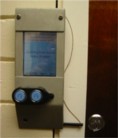
|
case study |
Hermes - electronic doorplates |
 |
||||||
|
||||||
see page 86. Design Focus: Hermes a situated displayYou have an appointment but are going to be late, so you ring a colleague and ask her to put a yellow sticky note on your door ... The first time it is OK, the second, ... but eventually you are embarassed each time you ask ... do you know the feeling. 
The Hermes system was a network of electronic displays mounted on the door frames of offices. The door owner can leave messages for people visiting the office and visitors can leave messages for the door owner. Imagine you are a student, Breathless you arrive at Alan's office. At near eye height you see an LCD screen beside the office door. It has a message on it "caught in traffic, running half an hour late". You breath a sigh of relief - you were 10 minutes late yourself for a 10 o'clock meeting, you even have time to go to the machine and buy a coke. Some time earlier, stationary in the long traffic queue Alan realised he was getting nowhere. He got out his mobile phone and sent the text message to the Hermes phone number. It knew from his mobile number who it was and routed the message to the correct door. As you drink you recall that you have a meeting with a different professor at 10:30, so you go back to Alan's office and click "Leave Note". You write a message with the stylus "seeing Prof. C, will call by later". You hope he will understand your handwriting. As you click 'confirm' the message disappears from the screen and Alan's message returns for the next visitor.
When Alan arrives he sits down, and opens his email. One of the messages is from Hermes including a bitmap image of the message left on the door. This reminds him that the door is still saying he is stuck in traffic, so he goes to the Hermes web site, logs in, changes the door display and also checks the other messages that have been left that morning. Later on Alan leaves his office, but as he shuts the door, he decides he ought to leave a message to say he is around. He logs into the door display and draws a message, as he logs out the message stays on his door for visitors to see later. Hermes raises a number of design issues:
Perhaps you could discuss this with your class? How many other issues can you think of?
text - Alan Dix, © 2003 |
|